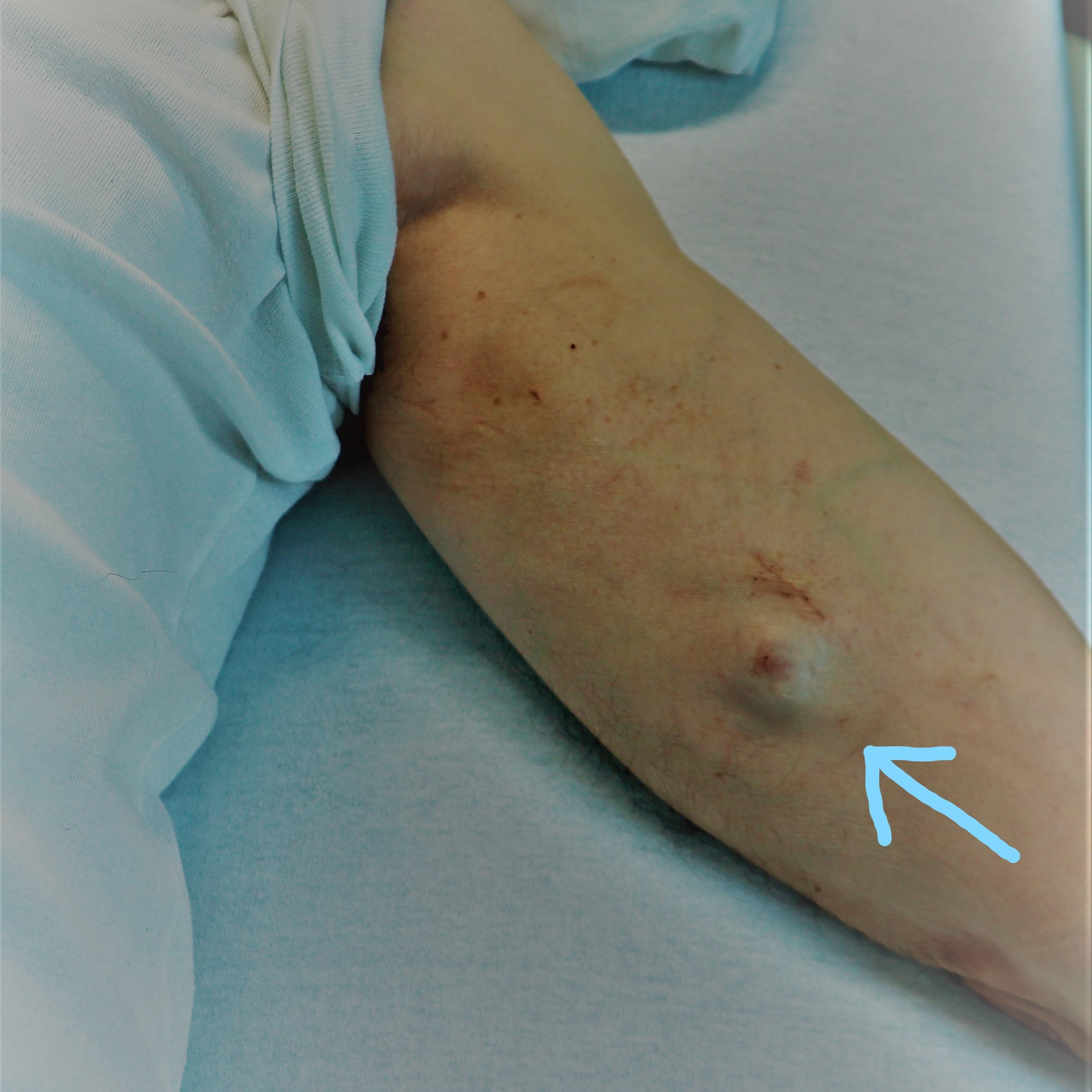Portal catheter
What is it?
What is it?In order to treat your disease, it is necessary to either prick you frequently with a needle to access the blood stream or to give you long-term intravenous (using a blood vessel) treatment. A portal catheter enables permanent access to a blood vessel. Such an access can be used for blood draws, injection contrast, administering intravenous feeding and administering medication that can irritate the blood vessel wall, such as chemotherapy. The portal catheter can also be placed in patients who have blood veins that are difficult to access.
In order to access the port, a nurse uses a special needle (Huber point needle) that will not harm the portal catheter. Some patients experience this as a bothersome feeling. If you wish, you may have a mild numbing salve (Emla) placed one hour before the portal catheter is accessed so that it will be painless.
Procedure
Procedure- You must be fasting for this procedure.
- Please inform the physician of any home medications (e.g. blood thinners) if you have allergies to medications.
The portal catheter is placed completely underneath the skin, either at the level of chest (e.g. classic portal catheter A) or on the inner side of the upper arm (arm port B).
A classic portal catheter is placed under general anaesthesia. For an arm port, only local anaesthesia is required. The procedure takes about 30 to 60 minutes. Afterwards, there will be a wavy area of skin visible where the portal catheter was placed, but it is so small that it is barely visible under your clothes. You will have a thin scar between one to four centimeters long after the procedure.
It is normal to have pain or an uncomfortable feeling at the portal catheter site for the first few days after it has been placed. You may take pain medication such as paracetamol for the pain. (Do not take pain medications whose active ingredient is acetyl salicylic acid, such as Aspirin, Aspegic, Perdolan Compositum, etcetera.)
Aftercare for a classic portal catheter
Aftercare for a classic portal catheterThe bandage should stay in place for ten days. If it is removed earlier than that, the bandage can be replaced. In order to prevent infection, it is important to keep the wound dry during this period of time. You may not shower or get the wound wet while bathing.
After ten days, you may remove the dry sterile bandage. There is no specific wound care required. The sutures will disappear on their own.
For the first four weeks after the portal catheter was placed, it is best to avoid exerting your arm and shoulder on the side that it was inserted.

Aftercare for an arm port
Aftercare for an arm portYou can remove the pressure bandage that was placed around your upper arm after 24 hours. The dry, sterile bandage that is underneath must be changed every two days to promote wound healing.
After ten days, if the wound has nicely closed, the dry, sterile bandage may be removed. There is no specific wound care required. The sutures will disappear on their own.
For the first four weeks after the portal catheter was placed, it is best to avoid exerting your arm and shoulder on the side that it was inserted.
Removal
RemovalThe portal catheter will remain in palce for the full duration of the treatment and for a short time afterwards. If there are complications, such as blockages or infection, the catheter may be removed sooner.
The portal catheter will be removed using local anaesthetic. This is done in consultation with your attending physician.
Advantages of a portal catheter
Advantages of a portal catheter- It is easier to administer medications using a convenient and quicker access point. The septum port is accessed easily using a simple needle.
- A portal catheter offers the possibility to administer large quantities of medication.
- The smaller blood vessels in the forearm are thus spared.
- You may take baths and shower.
- There is less chance of infection than with other catheters.
- A portal catheter may be used for blood draws.
- A portal catheter is made from high-quality and long-lasting materials.
Things to think about with a portal catheter
Things to think about with a portal catheterIf rinsing the catheter proves difficult or impossible, the nurse, GP or home care nurse may initially re-prick the needle and, if possible and without exerting additional pressure, rinse the catheter with a 0.9% physiological saline solution.
If this is not successful, please contact the Catheter Team.
If you have localised pain, redness or swelling, you should immediately contact your surgeon or hospital contact person. Also notify us immediately if there is secretion or pus at the wound site.
A thick or heavy-feeling arm can be a sign of a thrombosis in one of your arm's veins. If this occurs, you must conatct your surgeon or hospital contact person immediately.
Practical information for the patient
Practical information for the patient- Since the portal catheter is made out of artificial materials, it will not set off any alarms at places such as airport security. We do recommend, however, that you keep your implant card with you at all times.
- Take it easy the first few days after placement. Once the wound has healed, you may resume your normal activities such as bathing, running, etcetera. For the first four weeks after the portal catheter was placed, it is best to avoid exerting your arm and shoulder on the side that it was inserted.
- Reimbursement depends on your insurance company. In Belgium, it is always reimbursed by the health fund.
- The portal catheter is safe for testing such as computer tomography (CT) and magnetic resonance (MRI) scans, as well as any contrast that is administered.
- You must still wear a seatbelt, even when you have a portal catheter implanted in your chest.
Leaflet
LeafletOnly available in Dutch:

Poortkatheter
DownloadPractical information for care providers
Practical information for care providersPortal catheter: accessing and infusion
Portal catheter: temporarily stopping infusion to draw blood
Portal catheter: stopping infusion and disconnecting
Portal catheter: disconnecting chemotherapy pump
Cost estimate
Cost estimateCentres and specialist areas
Centres and specialist areas
Something wrong or unclear on this page? Report it.
Latest publication date: 13/08/2024





